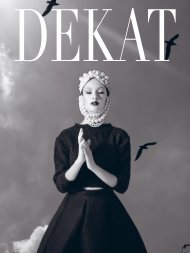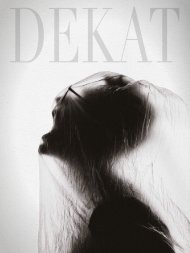1
You also want an ePaper? Increase the reach of your titles
YUMPU automatically turns print PDFs into web optimized ePapers that Google loves.
Organically, all these aspects of Outsider Art eventually gave it a distinct dynamic presence in the global art world through the publication of numerous magazines (for example,<br />
Raw Vision, Out of Art, and Outsider Art News) and monographs (the best-known being on artists Henry Darger, Martín Ramírez, Bill Traylor, and Adolf Wölfli). Authors such as John<br />
Maizels, Colin Rhodes and Gerard Werkin, among others, have contributed to writing Outsider Art’s histories, and Christina McCollum detailed the growing visibility of Outsider Art<br />
on the world stage in her 2017 dissertation Exhibitions of Outsider Art Since 1947 (City University of New York). New York has hosted an annual Outsider Art fair since 1993, and<br />
museums across the world now collect and display the genre, including the Museum of Folk Art (New York), the Metropole Museum of Modern, Contemporary and Outsider Art<br />
(Lille), Collection de l’ Art Brut (Lausanne), the Centre of Intuitive and Outsider Art (Chicago), American Visionary Art Museum (Baltimore), and the Museum of Naïve and Marginal<br />
Art (Jagodina, Serbia).<br />
Rigorous academic research is published in Elsewhere: The International Journal of Self-Taught and Outsider Art, edited by Colin Rhodes, put out by the Sydney College of the<br />
Arts (Australia), and dedicated websites are regularly updated, including Shannon Marie Robinson’s charming Outsider Art: Online Resources for Research. Ironically, publications,<br />
histories, exhibitions, art fairs, galleries, museums, academic research, and the like were traditionally constitutive elements of the exclusionary western art canon!<br />
Attempts to bridge the divide, or move marginalised art to the centre, has its own fascinating literature and exhibition history, ranging from the controversial William Rubin and Kirk<br />
Varnedoe exhibition, ‘Primitivism’ in 20th Century Art: Affinity of the Tribal and the Modern (MOMA, New York 1984), to Jean-Hubert Martin’s Magiciens de la Terre (Paris, 1989), Colin<br />
Rhodes’ publication Primitivism and Modern Art (Thames & Hudson, 1994) and Catherine Grenier’s Centre Pompidou exhibition, Multiple Modernisms 1905–1970 (2014), which all<br />
argue for the legitimacy of so-called ‘Ethnographic’ and Outsider Art in mainstream canonical art.<br />
The historiography of South African art history excludes local Outsider Art completely: no mention is found in Esmé Berman’s encyclopaedic Art and Artists of South Africa (AA<br />
Balkema,1974), Hans Fransen’s Three Centuries of South African Art (AD Donker, 1982), or the more recent Visual Century: South African Art in Context, edited by Mario Pissarro<br />
and others (WUP, 2011). Even in terms of contemporary art, Sue Williamson’s South African Art Now (Harper, 2009) and Ashraf Jamal’s In the World: Essays on Contemporary South<br />
African Art (Skira, 2015) mention no outsider artists. Rather, the lowly status of Outsider Art as marginal is reinforced by such publications as Gavin Younge’s Art of the South African<br />
Townships (Rizzoli,1988) and only somewhat challenged by Anitra Nettleton’s Engaging Modernities: Transformations of the Commonplace (Wits Art Galleries, 2003).<br />
The work of local outsider artists agitates for a revisionist approach to the history of South African art more broadly. Nukain Mabuza, Helen Martins, Titus Matiyane, Sibusiso Mbhele,<br />
Clifford Mpai, John Phalane, Solly Radile/Ratladi (‘Trolley Man’), Wilhelm Saayman and Tito Zungu, are mostly known through tourism brochures, websites, small catalogues, local<br />
newspaper articles, and a few academic studies, despite having captured the public imagination in Athol Fugard’s The Road to Mecca (stage play, 1985; film,1991) about Martins,<br />
and his more recent The Painted Rocks at Revolver Creek (2015), about Mabuza. Junebug, the 2005 film by Phil Morrison tells a similar story, but about a fictitious American outsider<br />
artist.<br />
What is particularly striking about South African outsider artists is the phenomenal sense of movement, latent or overt, in their work. Their driving force or inner compulsion readily<br />
finds visual expression in intimations of dynamic movement. Performative motion – through the air, on road, or along pathways – is innovatively captured in their work, in contrast to<br />
the monolithic fantasy structures created by some international outsider artists, including Das Junkerhaus (Germany), Le Musée Robert Tatin and Le Palais Ideal (France), Oiseaux<br />
Chausse Gros (Canada), Watts Towers (USA), and Nek Chand’s Rock Garden (India).<br />
Flying through the air (Mbhele, Zungu), moving along city streets (Mpai, Radile) travelling on camel back (Martins), or walking along pathways (Mabuza), South African outsider<br />
artists are mapping their terrain (Phalane), or panning cityscapes (Matiyane), and enabling the viewer to accompany them on their flights of fancy, by means of fanciful vehicles,<br />
makeshift airplanes and helicopters, box cars (Saayman), and even shopping trolleys (Radile).<br />
Nukain Mabuza’s painted rock garden, with delineated ‘rooms’ and ‘routes’ is essentially a manifestation of the cultural, historical, and religious contexts that might have shaped his<br />
personal vision and contributed to the form his particular expressive environment takes. His inhabited space in the garden is not static; his pathways imply movement, and direction,<br />
and purpose, demonstrating a unique sense of dynamism in his mind, and which the viewer experiences physically while similarly walking in his world.<br />
Helen Martins’ Owl House in Nieu-Bethesda, with more than 500 sculptures in the Camel Yard at the back, has legendary status in the global outsider art world. The cement camels<br />
and their riders are in perpetual motion on the way to the East, following the Star of Bethlehem, in search of a new birth, a new religion. The yard is testimony to Martins’ inner vision,<br />
the camels and their riders are frozen in time, but in eternal pursuit of a personal spirituality.<br />
302 FOR THE LOVE OF LIGHT<br />
FOR THE LOVE OF LIGHT 303





